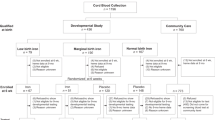Abstract
Objective: To describe the secular trends in the prevalence rates of iron-deficiency anemia (IDA) in infants in Israel, identify population group differences and assess the effectiveness of the 1985 Public Health directives on iron supplementation and avoidance of cow’s milk in the first year of life.
Design: A systematic analysis of published and unpublished cross-sectional studies.
Methods: IDA rates in 1-y-old infants between 1946 and 1997 were assessed from published papers and reports. Rates for Arab infants were available from 1984. Data on routine hemoglobin tests on 1-y-old infants for Arabs and Jews separately were obtained from four health districts for the period 1987 to 1997. Analyses were done for the periods prior to and following the Public Health directives.
Results: The prevalence of IDA in Jewish infants declined from 68% in 1946 to 50% in 1985 at an average annual rate of −1.43%. Following the iron supplementation directives, the average annual rate of decline increased to −4.0% and reached a prevalence of about 11% in 1996. IDA rates in Arab infants declined by an annual average of −3.7%, and were consistently almost twice as high as for Jewish infants.
Conclusions: Despite the contribution of the iron supplementation program to the reduction in IDA, the persistently high rates indicate inadequate iron content in the diet. This emphasizes the important role of a national food fortification program, using staple foods commonly consumed.
European Journal of Clinical Nutrition (2001) 55, 82–87
This is a preview of subscription content, access via your institution
Access options
Subscribe to this journal
Receive 12 print issues and online access
$259.00 per year
only $21.58 per issue
Buy this article
- Purchase on Springer Link
- Instant access to full article PDF
Prices may be subject to local taxes which are calculated during checkout
Similar content being viewed by others
Author information
Authors and Affiliations
Contributions
Guarantor: D Nitzan Kaluski.
Contributors: DNK designed the study, coordinated the data collection, carried out the analyses and drafted the paper. AL assisted with data collection and the writing of the paper. YA carried out the literature review and assisted with data collection. SR, SH, IB, MC-D, LR and SR all contributed data and reviewed the paper. YA and HP reviewed the data analyses and the paper.
Corresponding author
Rights and permissions
About this article
Cite this article
Nitzan Kaluski, D., Leventhal, A., Averbuch, Y. et al. Five decades of trends in anemia in Israeli infants: implications for food fortification policy. Eur J Clin Nutr 55, 82–87 (2001). https://doi.org/10.1038/sj.ejcn.1601119
Received:
Revised:
Accepted:
Published:
Issue Date:
DOI: https://doi.org/10.1038/sj.ejcn.1601119
Keywords
This article is cited by
-
Infant anemia is associated with reduced TLR-stimulated cytokine responses and increased nasopharyngeal colonization with Moxarella catarrhalis
Scientific Reports (2018)
-
Anemia as a risk factor for infectious diseases in infants and toddlers: Results from a prospective study
European Journal of Epidemiology (2005)



